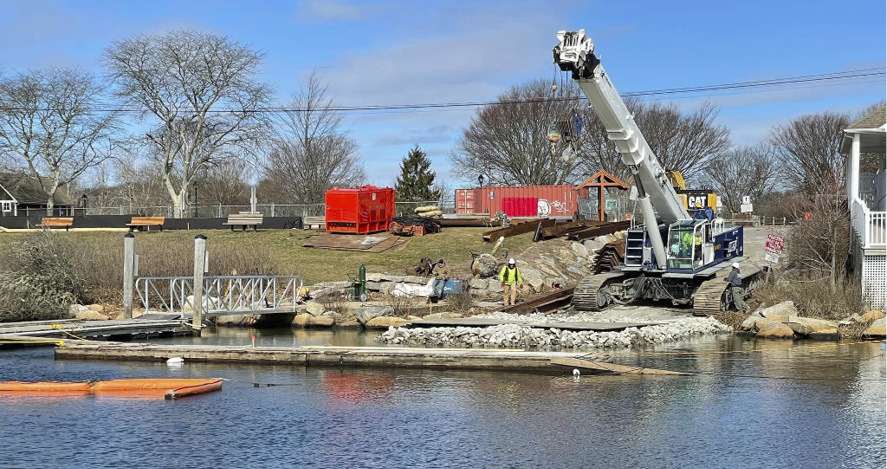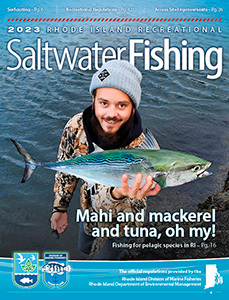Access Site Improvements

Main St, Westerly and Marina Park boat ramps under construction, more in the queue, as DEM supports public boating access with USFWS Sportfish Restoration dollars.
Construction of the public boat ramp at DEM’s facility on Main St in Westerly is moving along and on track to finish by Spring of 2023. Once complete, the Main Street boat ramp will provide an improved boating and fishing experience on the Pawcatuck River and can be enjoyed by more visitors. As DEM continues to expand recreational opportunities for people of all abilities, the site will have several features which facilitate access in accordance with the Americans with Disabilities Act (ADA). Plans developed by GZA GeoEnvironmental, Inc. include a one-lane concrete ramp with six floating docks. The parking lot circulation and layout will remain unchanged but updated signage is planned. There are 30 spaces for trailered boats, several spots for car top boats like kayaks or canoes, and ADA-accessible parking.
Demolition of the old ramp began in November 2022 by the contractor Atlantic Marine Construction. Boat ramps have an estimated functional life expectancy of 20 to 25 years depending on level of use and location, so this ramp was due for replacement. Amazingly, Bill Magowan, owner of Atlantic Marine, was part of the contractor crew for Pawcatuck River Dock Building, Inc. that built the original ramp in early 2000! Bill ended up buying that company with his business partner Brian Denecour and has continued in the business as Atlantic Marine Construction.
During the first phase of the project, the old, fixed dock and piles were removed, and steel sheet pile was installed to create a cofferdam, which makes it possible to complete the construction in dry conditions. That work was done from both the land side and by barge. A new concrete abutment will connect to the floating docks and replaces the fixed dock which was often fully flooded at high tide.
The new ramp is 68' long and has 34 pre-cast concrete slabs, and is constructed in the same 20-foot wide footprint as the original ramp. A concrete runoff slab was also set at the end of the ramp to help prevent scour holes from forming on the river bottom. New wooden pilings will be installed for the floating docks in April 2023 and boaters and anglers can anticipate the reopening of the facility in early May.
The Main Street Boat Ramp improvement project is funded with over $400,000 from the U.S. Fish and Wildlife Service Sport Fish Restoration Program, which derives its revenue from taxes on motorboat fuel, fishing equipment, and the purchase of some boats. A portion of the national funding is dedicated and distributed via DEM’s Division of Fish and Wildlife, specifically for boating access. Recreational boating and fishing are ingrained in the culture of the Ocean State. They also are important economic drivers: 54,000 boats use Rhode Island waters each year, including more than 40,000 registered to RI owners. The Sport Fish Restoration program fund allows for continued improvements to boating and fishing infrastructure across the state.
In addition to investing in state-owned boating facilities, DEM also provides support to municipalities in their efforts to upgrade public boat ramps. Most recently, work began to replace the popular boat ramp at Marina Park in South Kingstown. The Town contracted with New England Building and Bridge Company Inc. for the construction of the new ramp; completion of the project is estimated during Summer 2023. Plans for this facility, also completed by GZA GeoEnvironmental, Inc., include a new 24' wide ramp, two additional floating docks to provide more berthing space while boaters are launching or retrieving, and an accessible route to the new ramp. In addition to the Sport Fish Restoration dollars allocated by DEM, this boat ramp reconstruction is funded through the Town of South Kingstown Capital Improvement Program.
Two additional boat ramp projects are in the planning stage right now as well. The Town of Portsmouth received USFWS funding for engineering and design services for the Weaver Cove ramp on Burma Road, as did the Town of North Kingstown for their ramp at Wilson Park. Both projects are awaiting final permits.
DEM will continue to invest in boating facilities to provide safe and accessible experiences for boaters, anglers, and outdoor enthusiasts, and looks forward to sharing more great projects in 2024.


